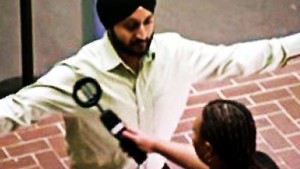Articles/Opinion
US: To the TSA, a Sikh man is a target in a turban: by Arjan Sethi
November 30, 2013 | By Sikh Siyasat Bureau
author: Arjun Sethi*
A few weeks ago, I headed to the airport for a flight from Washington to Boston. When I arrived, I began a familiar routine. I scanned the flight schedule board, checked in my bag and headed to security. There, I removed my jacket, scarf, shoes and belt. A Transportation Security Administration (TSA) officer motioned me to walk forward. I stepped not too fast, not too slowly and without a beep. I passed the test — or so I thought. Almost immediately, the officer directed me to the corner, where another officer and an army of machines waited.
I was about to undergo secondary screening. Why? Because I wear a turban. For Sikh Americans, humiliation is a prerequisite to air travel.
It’s not clear when my turban became a subject of suspicion. Sikhism dates to the 15th century and has 23 million followers worldwide. Sikhs first immigrated to the United States more than 100 years ago; they helped build the transcontinental railroad. Many Sikhs are distinguishable by their hair, which they grow long as an article of faith and cover with a turban — a long, neatly folded cloth that comes in many colors and styles. Manmohan Singh, the prime minister of India, wears one. So do hundreds of thousands of Sikh Americans.
As I trudged to the corner, boarding pass in hand, an agent announced the TSA policy: My turban had to be patted down. Either I could or he would.
Had I wanted to protest, that would have been the time. I have considered speaking out on many trips, yet I’ve always remained silent. Maybe that’s because airports are diminished-rights zones, where the public must surrender certain liberties. Would expressing my identity really stand a chance? Or perhaps I just don’t want to be the angry minority who causes a scene at airport security.
This time I got off easy. I’ve had officers simply announce their intention and then prod my turban like they’re mining for gold.
I gently brushed my hands across the blue cloth and nudged a few corners. Insufficient, the officer said. I tried again. This time I poked and pulled. Thirty seconds later he was satisfied and swabbed my hands for bomb residue. The machine malfunctioned and a few minutes passed. So did about a dozen travelers and a few suspicious glances.
“All clear,” the officer said. As I dressed, I heard him whisper, “Sorry, man. Sikhs get a raw deal.”
The TSA justifies this raw deal by saying that all bulky clothing, not just turbans, may prompt secondary screening. Yet over the years, I’ve gone through security next to passengers wearing bell-bottoms or hefty sweaters — even one wearing a leg brace — and they weren’t singled out. In response to thousands of Sikh travelers voicing similar concerns, the Sikh Coalition last year launched FlyRights, a mobile-phone application that allows travelers to instantly report misconduct or bias by TSA officers.
During a 2009 meeting with Sikh advocates, TSA officials provided a partial explanation for the disparate treatment. When I asked why turbans are treated differently, an engineer responded that the human head is a particularly amenable place for hiding an improvised explosive device because its weight can be equally distributed. After a brief silence, he looked as befuddled as I did.
The TSA officials present at that meeting promised that advanced imaging technology, which the agency had started to roll out, would eliminate the need for pat-downs. That turned out not to be true. The invasive technology can filter through layers of cloth to illuminate travelers’ genitals but apparently not their hair.
It’s hard to know whether second-class citizenship at U.S. airports has long-term consequences. Perhaps it fuels misunderstanding and bias. Sikhs have been the victims of countless hate crimes and bias-related incidents since the Sept. 11, 2001, attacks. Just two months ago, a Columbia University professor was assaulted by a group of assailants on bicycles. Earlier this year, truck driver Jagjeet Singh was taunted by Mississippi authorities after he had been pulled over. At a subsequent hearing, he was asked to leave the courtroom because the judge didn’t like his “rag.”
There is no way of quantifying what singling out Sikh passengers does to the public perception of Sikhs — nor what it does to its victims, including Sikh children, who aren’t usually exempt from this intrusion.
What is certain, however, is that it mocks the Constitution’s promise of democracy for all and unravels the myth of equality under the law. When I’m pulled aside and others walk by, it amounts to not just delay, inconvenience and awkwardness in being separated from friends and colleagues. It’s a pronouncement that Sikh Americans are outsiders. That an institution meant to serve and protect me has cast a net of suspicion over my entire community. That an article of faith that is older than the nation in which I live is now an article of suspicion.
* Arjun Sethi is a lawyer in Washington. He is on Twitter: @arjunsethi81.
** Please Note: Above write-up was previously published by “The Washington Post” with title: “To the TSA, a Sikh man is a target in a turban” by Arjun Sethi. It is reproduced here for the information of readers/visitors of the Sikh Siyasat News (SSN).
*** Readers/visitors may find this write-up on its source page at: http://www.washingtonpost.com/opinions/sikh-americans-raw-deal-at-airport-security/2013/11/29/8aab1dc6-5790-11e3-8304-caf30787c0a9_story.html
To Get Sikh Siyasat News Alerts via WhatsApp:
(1) Save Our WhatsApp Number 0091-855-606-7689 to your phone contacts; and
(2) Send us Your Name via WhatsApp. Click Here to Send WhatsApp Message Now.
Sikh Siyasat is on Telegram Now. Subscribe to our Telegram Channel
Related Topics: Sikhs in United States, Transportation Security Administration (TSA), United States of America





